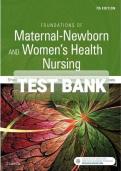Exam (elaborations)
TEST BANK For Foundations of Maternal-Newborn and Women’s Health Nursing 7th Edition | Complete Guide A+
- Course
- Institution
- Book
TEST BANK with Complete Questions and Solutions. To clarify, this is the TEST BANK, not the textbook. You get immediate access to download your test bank. You will receive a complete test bank; in other words, all chapters will be there. Test banks come in PDF format; therefore, you do not need spe...
[Show more]



